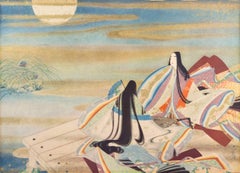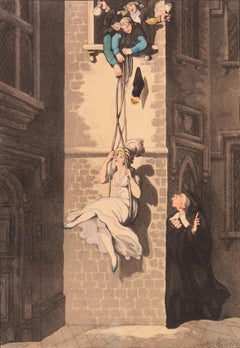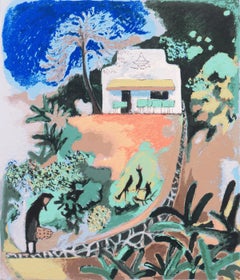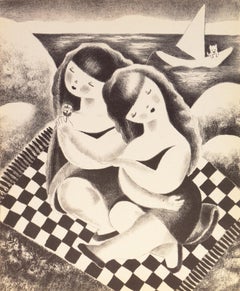Want more images or videos?
Request additional images or videos from the seller
1 of 13
Ogyu Tensen'Musicians Viewing the Full Moon', Large Japanese Color Woodblock Print, Biwa
$5,500List Price
About the Item
- Creator:Ogyu Tensen (1882 - 1947, Japanese)
- Dimensions:Height: 23.5 in (59.69 cm)Width: 33 in (83.82 cm)
- Medium:
- Period:
- Condition:minor age toning and surface marks, uneven top edge; unframed; shows well.
- Gallery Location:Santa Cruz, CA
- Reference Number:1stDibs: LU344489012
About the Seller
5.0
Gold Seller
Premium sellers maintaining a 4.3+ rating and 24-hour response times
Established in 1982
1stDibs seller since 2013
750 sales on 1stDibs
Typical response time: 1 hour
Authenticity Guarantee
In the unlikely event there’s an issue with an item’s authenticity, contact us within 1 year for a full refund. DetailsMoney-Back Guarantee
If your item is not as described, is damaged in transit, or does not arrive, contact us within 7 days for a full refund. Details24-Hour Cancellation
You have a 24-hour grace period in which to reconsider your purchase, with no questions asked.Vetted Professional Sellers
Our world-class sellers must adhere to strict standards for service and quality, maintaining the integrity of our listings.Price-Match Guarantee
If you find that a seller listed the same item for a lower price elsewhere, we’ll match it.Trusted Global Delivery
Our best-in-class carrier network provides specialized shipping options worldwide, including custom delivery.You May Also Like
Modern American Industrial Landscape
Located in Buffalo, NY
An original woodblock print dated 1965, titled "Our Town" but signed illegibly.
Category
1960s American Modern Figurative Prints
Materials
Paper, Woodcut
"Dawn Inside the Yoshiwara" Utagawa Hiroshige, Japanese Landscape, Ukiyo-e
By Utagawa Hiroshige
Located in New York, NY
Utagawa Hiroshige
Dawn Inside the Yoshiwara, circa 1857
Woodblock print
11 x 7 inches
Utagawa Hiroshige is recognized as a master of the ukiyo-e woodblock printing tradition, havin...
Category
1850s Naturalistic Figurative Prints
Materials
Paper, Ink, Woodcut
Fin de Journée
By Auguste Lepère
Located in Middletown, NY
Paris: Sagot, 1889.
Wood engraving on cream laid Japon paper with full deckle edges, 8 3/8 x 5 3/4 (212 x 145 mm). Signed, numbered 9/35, and inscribed "1er Etat" in pencil in the l...
Category
Late 19th Century French School Landscape Prints
Materials
Handmade Paper, Woodcut
KCHO (Alexis Leyva Machado), ¨Untitled (Triptych)¨, 2019, Woodcut, 44.7x93.3 in
By KCHO (Alexis Leyva Machado)
Located in Miami, FL
Alexis Kcho Leiva (Cuba, 1970)
'Untitled (Triptych)', 2019
woodcut on paper Velin Arches 300 g.
44.7 x 93.4 in. (113.5 x 237 cm.)
Edition of 30
ID: KCH-118
Unframed
Category
2010s Contemporary Landscape Prints
Materials
Paper, Woodcut, Ink
KCHO (Alexis Leyva Machado), ¨Untitled II¨, 2019, Woodcut, 44.7x31.1 in
By KCHO (Alexis Leyva Machado)
Located in Miami, FL
Alexis Kcho Leiva (Cuba, 1970)
'Untitled II', 2019
woodcut, silkscreen on paper Intaglio 300 g.
44.7 x 31.2 in. (113.5 x 79 cm.)
Edition of 30
ID: KCH-120
Unframed
Category
2010s Contemporary Landscape Prints
Materials
Paper, Woodcut, Ink
KCHO (Alexis Leyva Machado), ¨Untitled III¨, 2019, Woodcut, 44.5x31.2 in
By KCHO (Alexis Leyva Machado)
Located in Miami, FL
Alexis Kcho Leiva (Cuba, 1970)
'Untitled III', 2019
woodcut, silkscreen on paper Intaglio 300 g.
44.5 x 31.2 in. (113 x 79 cm.)
Edition of 30
ID: KCH-119
Unframed
Category
2010s Contemporary Landscape Prints
Materials
Paper, Woodcut, Ink
Toshogu Shrine
Located in Middletown, NY
In image of the Tokugawa family paying homage to Tosho-gu Shrine in Nikko.
Tokyo: Matsuki Heikichi, 1896
Woodcut in ink with embossing and hand-coloring in watercolor on handmade m...
Category
Late 19th Century Edo Figurative Prints
Materials
Watercolor, Handmade Paper, Woodcut
The Battle of Dan-no-ura in Yashima, Nagato Province in the First Year .....
By Utagawa Yoshitora
Located in Middletown, NY
The Battle of Dan-no-ura in Yashima, Nagato Province in the First Year of the Bunji Era (1185)
Tokyo c. 1830
Woodblock print (nishiki-e) with ink and hand-coloring in watercolor on handmade mulberry paper, 14 7/16 x 9 15/16 inches (367 x 252 mm), ōban tate-e, the full sheet. In good condition with some handling creases. Colors are fresh and extremely vibrant. The right panel from the triptych by Yoshitora depicting one of Japan's most storied naval battles. An impression of this work may be found in the permanent collection of the Honolulu Museum of Art.
The great naval battle of Dan-no-ura in 1185 was the final climax in a long series of bitter wars between two powerful families in feudal Japan...
Category
Early 19th Century Edo Figurative Prints
Materials
Watercolor, Handmade Paper, Woodcut
$1,500
H 14.44 in W 9.94 in
Ôkubo Hikozaemon Protects the Hidden Shogun Triptych
By Taiso Yoshitoshi
Located in Burbank, CA
“War Chronicles of Osaka” (Osaka gunki no uchi). Okubo Hikozaemon, raising his sword, protects the hidden Tokugawa shogun from the spear of Gorô Matabei Mototsugu in a moonlit fores...
Category
1880s Other Art Style Figurative Prints
Materials
Mulberry Paper, Woodcut
$4,975
H 14.69 in W 29.14 in
Japanese Beauty Admiring Kirifuri Waterfall
By Yoshu Chikanobu
Located in Burbank, CA
A beauty turns to admire the Kirifuri Waterfall in Nikko Province. She holds the handle of an umbrella and wears fashionable clothing that is beautifully printed. This series pairs f...
Category
1890s Edo Landscape Prints
Materials
Handmade Paper, Mulberry Paper, Woodcut
$940 Sale Price
20% Off
H 14.02 in W 18.67 in
More From This Seller
View All'Musicians Viewing the Full Moon', Large Japanese Color Woodblock Print, Biwa
By Ogyu Tensen
Located in Santa Cruz, CA
Signed, lower right, with artist's chop mark in Hiragana, 'Tensen-e' 天泉絵, for Ogyū Tensen 荻生天泉 (Japanese, 1882-1947)
A large, early-20th-century, hand-colored Japanese woodblock sho...
Category
1920s Figurative Prints
Materials
Paper, Fiberboard, Woodcut
'A College Trick', English Satirist, London's Royal Academy, Comedic, Benezit
By Thomas Rowlandson
Located in Santa Cruz, CA
An amusing view of an academic wagging his finger in disapproval as a young lady in a rope seat is pulled up to a college dorm window by a group of revelling students.
Thomas R...
Category
18th Century Figurative Prints
Materials
Paper, Engraving, Lithograph
'Mimosa Tree Restaurant', Aegean, Cyclades, Japanese Artist in Greece, Feral Cat
Located in Santa Cruz, CA
Signed lower right, 'Hirano' for Yoshito Hirano (Japanese, born 1938) and created circa 1970; titled, verso, 'Mimosa Tree Restaurant'.
Paper dimensions: 28 x 23 inches.
A verticall...
Category
1970s Modern Landscape Prints
Materials
Paper, Lithograph
'Mimi and Bemi', Art Student's League, Salon d'Automne, Paris, Art Deco, Surreal
By Nura Ulreich
Located in Santa Cruz, CA
A mid-century, stone lithograph titled 'Mimi and Bemi' by Nura Woodson Ulreich (American, 1899-1950), created in 1943 and with certification of authenticity stamped verso. Accompanie...
Category
1940s Figurative Prints
Materials
Paper, Lithograph
'David, Walter & Blake', Woman Artist, Art Deco, Children, Walker Art Center
By Nura Ulreich
Located in Santa Cruz, CA
A stone lithograph titled 'David, Walter and Blake' by Nura Woodson Ulreich (American, 1899-1950), created in 1943 and with certification of authenticity stamped verso. A crisp and f...
Category
1940s Figurative Prints
Materials
Paper, Lithograph
'Bert, Bob and Betsy', Paris, Salon d'Automne, New York, ASL, Corcoran, PAFA
By Nura Ulreich
Located in Santa Cruz, CA
A stone lithograph titled 'Bert, Bob and Betsy' by Nura Woodson Ulreich (American, 1899-1950), created in 1943 and with certification of authenticity stamped verso. A bright and fres...
Category
1940s Figurative Prints
Materials
Paper, Lithograph



